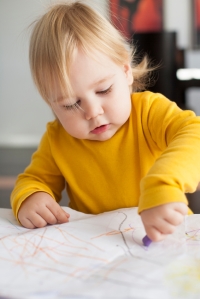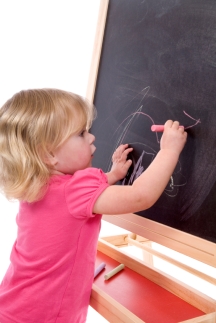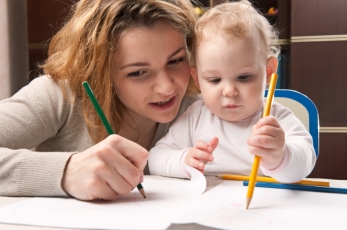 Children learn about writing long before they are able to write themselves. They discover more about written language each time they see print in their environment. It was once believed that children would not be able to write until they had mastered the basic aspects of spoken language, but children are “writing” when they experiment with different paint strokes or when they scribble various marks across a paper. We now know all developmental aspects of early literacy (speaking, reading, and writing) build on each other and develop simultaneously.
Children learn about writing long before they are able to write themselves. They discover more about written language each time they see print in their environment. It was once believed that children would not be able to write until they had mastered the basic aspects of spoken language, but children are “writing” when they experiment with different paint strokes or when they scribble various marks across a paper. We now know all developmental aspects of early literacy (speaking, reading, and writing) build on each other and develop simultaneously.
As with any developmental skill, children learn to write in their own manner and at their own pace. It is not reasonable to expect preschool children to be able to control a pencil with great accuracy, to form letters perfectly, or to write a story. Children at this age are just learning to grasp a writing instrument, their written language may be nearly unrecognizable, and their explanation of what they have written may change each time they are asked. Although each child learns differently, there are stages of writing that have been found to be fairly typical among young children.
Children’s first attempts at writing resemble scribbles (dots, lines, zigzags, loops, circles, etc.). Scribbles and marks progress into sometimes recognizable letters placed randomly on a page. Eventually, children’s writing will be clearly left-to-right, top-to-bottom in organized fashion across a page. However, a lot has to happen before this is possible.
Fine motor control, knowledge of vocabulary and grammar, and the ability to organize thoughts and ideas are all necessary aspects of mature writing. There are numerous ways to encourage children to experiment with written language:
 Provide access to a variety of writing utensils and papers. Suggestions include crayons, markers, colored pencils, lead pencils, gel and ink pens, chalk, construction and copy paper, blank forms, blank greeting cards, envelopes, and notepads.
Provide access to a variety of writing utensils and papers. Suggestions include crayons, markers, colored pencils, lead pencils, gel and ink pens, chalk, construction and copy paper, blank forms, blank greeting cards, envelopes, and notepads.- As children express interest, show them how to write their names and other familiar words. Many times, the first letter of a child’s name is the first letter he is able to write. Avoid critiquing his neatness, spelling, or grammar.
- Provide opportunities for fine motor practice. Grasping and controlling a writing utensil is hard for young children to do, so invite them to practice lacing, cutting, zipping, drawing, etc. to develop their small muscles.
- Make sure they see you writing! Young children often imitate the things they see the familiar people in their lives doing, so make sure they see you writing for pleasure (letters, greeting cards, poetry) and for specific purposes (filling out forms, writing checks, making lists).
 As children create drawings and paintings, ask them to tell you about their work. Offer to write their words on the pictures.
As children create drawings and paintings, ask them to tell you about their work. Offer to write their words on the pictures.- Invite children to help you write a letter or greeting card to someone special. Ask them what they would like to say and write it for them if they are unable to. Have them sign (or scribble) their names.
- Most of all appreciate their efforts and emphasize what they did correctly. Mistakes will happen for children of all ages. The English language consists of 26 letters which represent 44 sounds! Always encourage them to keep trying.
Research has shown that literacy is one of the best indicators for success in school and adulthood. It is our responsibility, as parents and teachers, to provide opportunities to support literacy development in children during the critical early years from birth to age eight. Doing so will ensure children reach their reading and writing potential.
To read more on the fundamental aspects of early literacy, see our tips on Language Development and Reading Development.
Back to blog listing